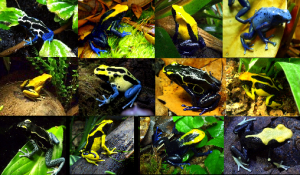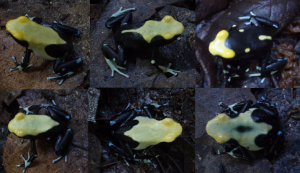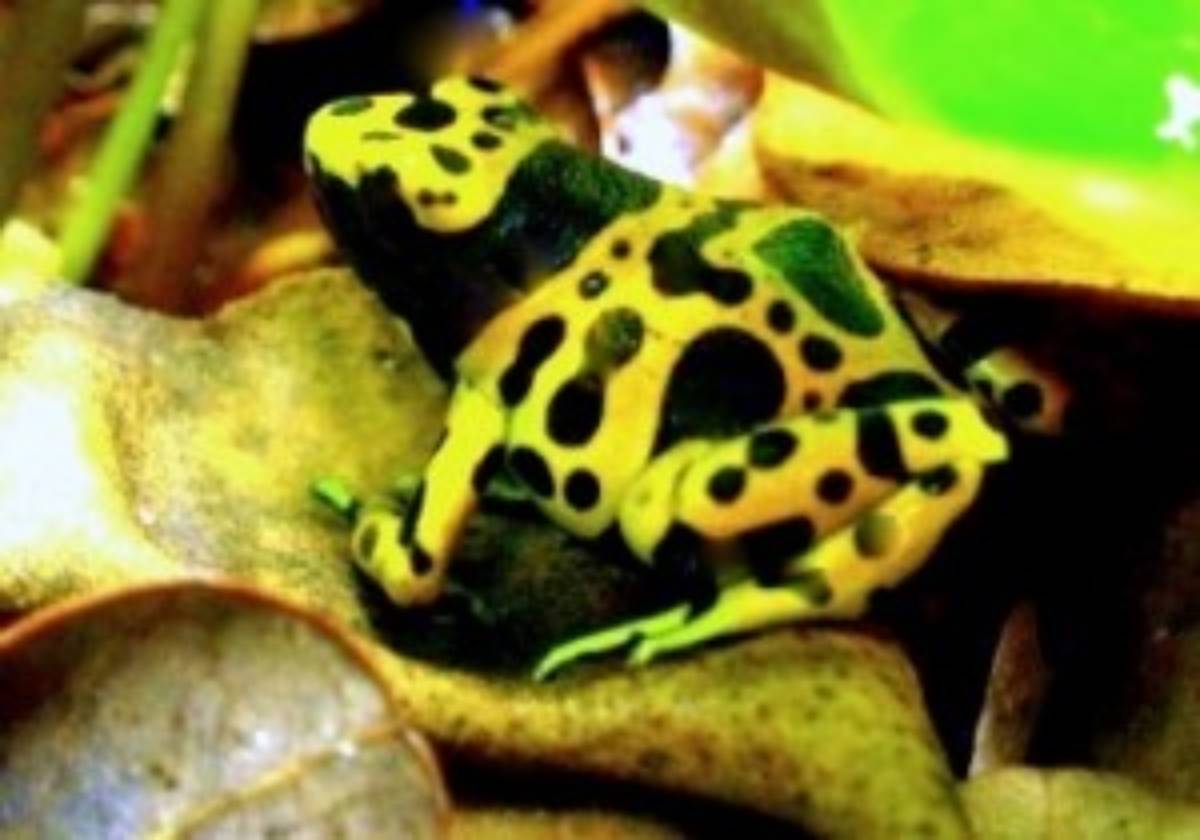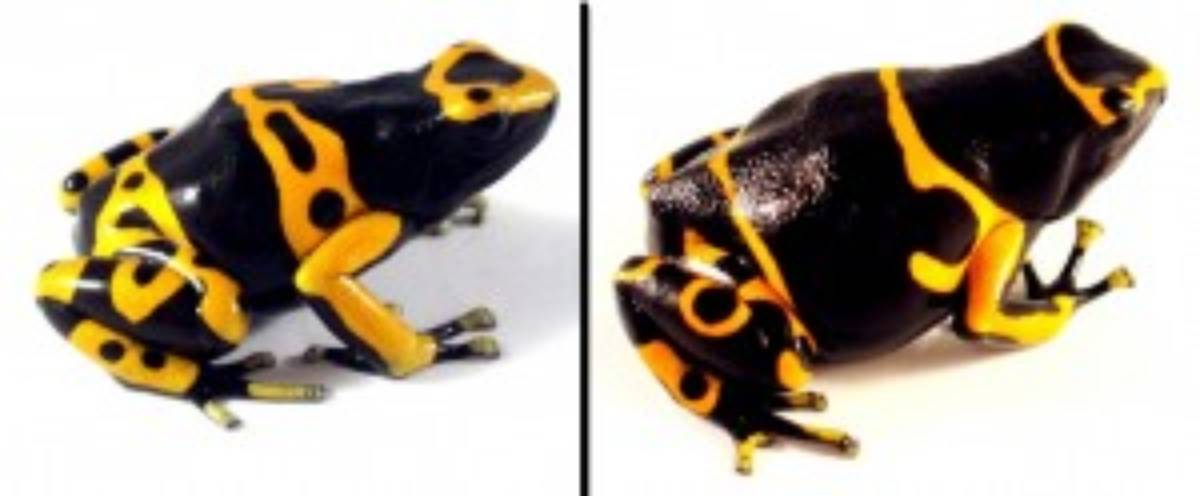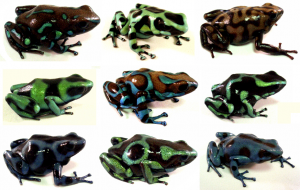Josh's Frogs
Why you should buy from us
Hopping into the Hobby
3 Great 'Starter Frogs' for Beginners
Few things draw as much attention at pet stores or reptile shows as Poison Dart Frogs. They are colorful, active, and interesting captives which are fairly easy to care for. Not all species are as forgiving as others, however. The following 3 species of PDFs are much more resistant to common mistakes made by new frog owners, and make a great first frog for those new to the dart frog hobby.
The Dyeing Poison Arrow Frog – Dendrobates tinctorius
Dendrobates tinctorius, or tincs as they are known in the hobby, are large, colorful frogs that occur over a wide area in the South American countries of Brazil, Guyana, French Guiana and Suriname, with most of the locales available in the hobby hailing from Suriname.
Each population of Dendrobates tinctorius possesses unique colors and patterns – these different locales can vary widely in adult size and aggression as well.
Dendrobates tinctorius vary greatly as a species. Each color morph represents a unique population in the wild, and should not be mixed with other populations.
From left to right, top to bottom: Oyapok, Brazilian Yellow Head, Citronella, Azureus, Matecho, Patricia, Suriname Cobalt, Giant Orange, Powder Blue, Regina, Lorenzo, Yellow Back.
Given this wide array of colors and patterns, it is tempting to mix and match several different morphs, to create a colorful group of animals in the vivarium. However, this is not a good choice – not only can these different populations of tincs crossbreed, they also tend to not get along with each other in the long run, leading to fighting and casualties. The different morphs of Dendrobates tinctorius are best left to their own individual vivariums.
Just because different populations of Dendrobates tinctorius should not be mixed does not mean that you cannot have a diverse group of frogs in the vivarium. Above are 6 sibling Dendrobates tinctorius 'Yellowback'.
Adult tincs typically measure from 1.25-2.5 inches depending on morph and age. These frogs can get quite large, and are best kept with sturdy plants in the vivarium, such as pothos. They can trample small, delicate vivarium plants.
Dendrobates tinctorius are primarily a ground-dwelling frog, and are better suited to large, horizontally oriented vivaria, where they will spend most of their time exploring the leaf litter hunting for microfauna. Their call Is a very faint buzz, which is nearly inaudible.
Tincs are fine raised in groups as froglets, but sometimes do need to be split up as they age. Dendrobates tinctorius is sexually mature at 10-14 months of age for most locales. They typically lay their eggs on smooth leaves or under coco huts. Adult females can fight with each other over access to a mate, so it is best to limit the group to one mature female. These bold and outgoing vivarium inhabitants can with well over two decades if cared for properly.
The Bumble Bee Poison Dart Frog – Dendrobates leucomelas
Dendrobates leucomelas, known as the Bumblebee Poison Dart frog, or Leuc, in the trade, makes another great beginner frog. They are active, bold, and do great in groups – typically, the only problem you may run into will be females eating each others' eggs.
They display very contrasting yellow and black bands, and have a loud, pleasant call. They naturally occur in Venezuela, Guyana, Brazil, and eastern Colombia.
Dendrobates leucomelas 'Fine Spot'. Leucs come in a variety of patterns, each probably representing a population or locale in the wild.
There are 2 predominate 'morphs' of Dendrobates leucomelas in the hobby – Standard Leucs (commonly just referred to as 'Leucs') and Banded Leucs. Standard leucs hail from a number of imports originating in Venezuela. Most of these animals in the trade have been mixed together over time, and the resulting animals available today are most likely a mix of various imports (and most likely various locales or populations). It is possible to track down import-specific animals from dedicated private hobbyists. Standard leucs tend to be bold, unafraid captives, constantly out and about in the vivarium. The males will typically call very frequently in a high pitched, canary-like voice.
Banded leucomelas, also known as Guyana leucs, hail from British Guyana. There may be multiple populations of these animals represented in the hobby, but the relationship is unclear at best. Arguably, there are 3 notable phenotypes present – animals that are mostly black as adults, animals that are approximately 50/50 yellow and black with very evenly spaced bands (these resemble Oophaga lehmanni), and animals that closely resemble standard leucomelas but are much larger (currently referred to as 'Guyana Yellow' Leucs in the hobby). All three of these forms seem to breed true (their offspring resemble the parents), and it is my personal belief they represent isolated collection points, if not distinct populations. Banded leucs tend to be more reclusive than standard leucs, spending much less time out and about in the vivarium. They also call less frequently, and can be more difficult to breed.
There are 2 distinct 'morphs' of Dendrobates leucomelas commonly encountered in the hobby - "Standard” Leucs (left) and “Banded” Leucs (right). Several other morphs/locales/imports exist, but are much harder to find.
Other 'morphs' of Dendrobates leucomelas in the hobby include Fine Spot/Small Spot leucomelas, Green foot leucs, and chocolate leucs (which are actually homozygous for a recessive trait, and have been intentionally bred – they do not represent a population in the wild). Different types of leucs are best housed separately from each other.
Dendrobates leucomelas reach sexual maturity at 6 to 12 months. It's not uncommon for males to begin calling as early as 6 months, but it typically takes females several more months to mature. Leucs prefer to lay on smooth leaves or on petri dishes under coco huts in the vivarium, much like Dendrobates tinctorius. They can be seasonal breeders, producing for a couple months at a time, between breaks of several months. In the wild, they are subject to severe dry seasons and temperature fluctuations, which explains this behavior. Their ability to not only survive, but thrive, in such seasonal conditions makes them a notably hardy species in captivity, especially when it comes to heat tolerance. They will utilize every inch of the vivarium, and are much more prone to climbing than many heavy-bodied frogs of a similar size.
The Green and Black Dart Frog – Dendrobates auratus
Auratus, as they are known in the trade, are another great addition to our list of beginner dart frogs. They are strikingly colored, and vary widely based on populations (and sometimes among the same population). Auratus are easy to breed, keep, and make great group animals, displaying almost no aggression in most situations.
Dendrobates auratus come in a wide variety of color and patterns.
From left to right, top to bottom: Camo, Costa Rican Green and Black, Kahula and Cream, Nicaraguan Green and Black, Highland Bronze, Panamanian Green and Black, Panamanian Blue and Black, Hawaiian (Tobaga Island, Panama), and Turquoise and Bronze.
Dendrobates auratus are the least bold frogs on this list, and can be fairly reclusive in the vivarium. There are steps you can take to increase their visibility, however. Ensure the frogs are provided with a well-planted vivarium, include a thick layer of leaf litter, and provide plenty of visual barriers to make the frogs feel more comfortable. Auratus are often found near small streams in the wild – providing them with a small water feature, such as a pond or stream, in the vivarium will encourage them to venture from their hiding places more often, and will be utilized for breeding activity. Constructing ledges or cracks in the background that auratus can squeeze into (so that their back is in contact with the ledge above them) will make the auratus feel more secure. Most importantly, placing the vivarium in an area of the home that gets a lot of foot traffic will familiarize the frogs to intrusion, and cause them to pay less notice of being observed.
Auratus typically mature around 8-12 months. Depending on the morph, males are generally 1-1.5 inches, with females being about 0.25-0.5 inches longer. Mature females also display a characteristic pear shape that is apparent when they are carrying eggs. Their call is a faint buzzing that is barely audible unless you are in the vivarium with them! They are easy to breed (with some exceptions), and typically lay 4-8 eggs every couple of weeks. The smaller forms of auratus will lay in film canisters, but all will lay on smooth leaves or on petri dishes under coco huts.
Conclusion
Starting out in the hobby can be an overwhelming task. Dart frogs are by no means difficult captives, but there is a lot of information out there to sort through before bringing your first frogs home. Hopefully, this guide will have answered some common beginner questions, and put you on the right foot starting out in the very rewarding hobby of poison dart frog keeping.


